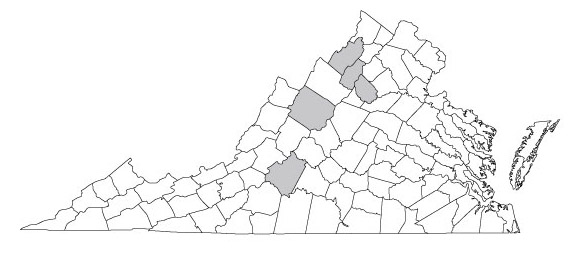Virginia Land Snails
.jpg)
Photo(s): Pallifera varia by Megan Paustian ©.
Click photo(s) to enlarge.
Pallifera varia Hubricht, 1953
Family: Philomycidae
Common name: Variable Mantleslug
Identification
Length: 50-65 mm
Pallifera varia is a large Pallifera and like other philomycids has a mantle that covers the entire dorsal surface of the animal. The mantle is tannish grey with moderate sized darker brownish grey spots and smaller whitish spots. The edges of these spots are not sharply defined giving the mantle a marbled look. The darker spots often coalesce to form a weakly defined central band and two lateral bands that run the length of the mantle. The margin of the foot, especially the anterior, is edged with reddish-brown. The reproductive system is not equipped with a dart sac. The jaw has six to nine ribs.
Ecology
This species is a relatively common but rarely seen inhabitant of upland hardwood forests near the summits of the Blue Ridge at elevations above about 700 meters. This slug is most abundant where there is an ample supply of rotting wood and also appears to prefer sites with loose rock and talus. Pallifera varia has been observed feeding on crustose lichens, especially Aspicillia gibbosa and appears to avoid Xanthoparmelia cumberlandia and Huilia albocaerulescens (Lawrey, 1980).
Distribution
Pallifera varia is endemic to Virginia and is found from Rappahannock County south to Bedford County along the summits of the Blue Ridge. Nearly all its range is on protected lands in Shenandoah National Park and the Blue Ridge Parkway. Although reasonably secure, large fires, removal of downed wood, and acid rain are factors that could potentially impact this species.
NatureServe Global Rank: G2/G4
NatureServe State Rank: S2?
Virginia’s wildlife action plan: Tier III
John Slapcinsky 10/2012
Range Map



